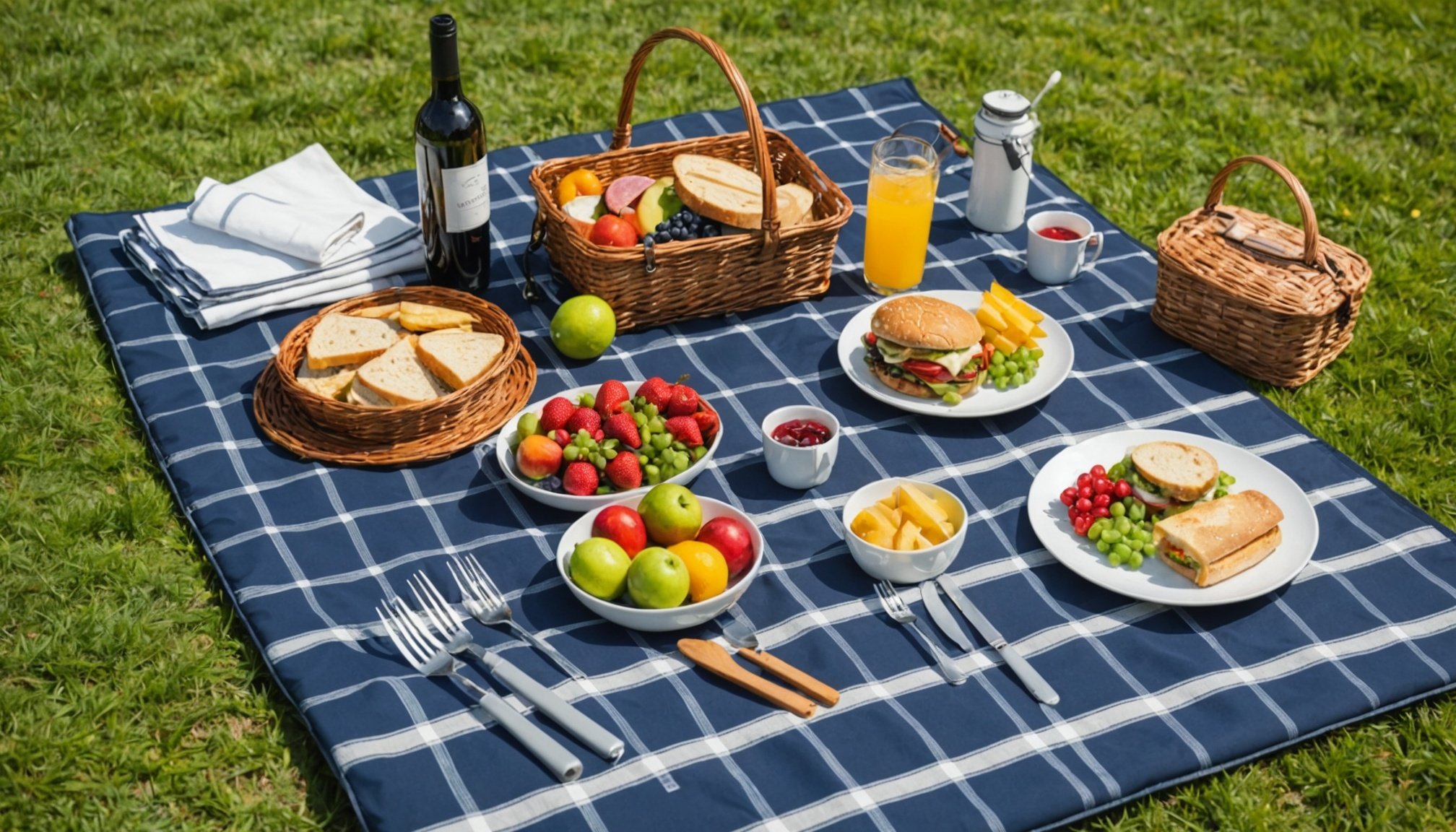Understanding the British Climate
The British climate is known for being diverse and unpredictable, presenting a unique blend of weather conditions throughout the year. Generally, the country experiences mild summers, cool winters, and a fair amount of rainfall, making it essential to consider this when selecting items like picnic blankets. Understanding these weather patterns is crucial for outdoor activities, as temperatures can fluctuate greatly between seasons.
- Typical Weather Patterns
- Wet and windy in autumn and winter.
- Mild, yet occasionally warm in spring and summer.
Seasonal variations significantly impact the choice of fabric, especially in picnic blankets. During colder months, warmth and insulation become primary concerns, whereas in warmer seasons, breathability and moisture resistance take precedence. Choosing a blanket that caters to these needs ensures comfort, no matter the weather.
This might interest you : Ultimate Guide to Styling Maxi Dresses for an Enchanting Beach Wedding in the UK
When selecting picnic blankets, it’s important to weigh the impact of local weather. For instance, waterproof fabrics are essential to withstand sudden showers. The fabric’s ability to withstand different weather can enhance outdoor experiences, making them more enjoyable and worry-free. As we explore fabric types, each comes with distinct benefits tailored to meet the challenges posed by British weather conditions, enhancing the overall picnic experience.
Key Fabric Types for Waterproof Picnic Blankets
Selecting the right waterproof fabrics is crucial for making an outdoor gathering comfortable and stress-free, especially in the unpredictable British climate. Two major categories of fabrics are considered: synthetic and natural.
Also read : Unearth the Finest British Custom Boot Brands: The Definitive Guide to Mastering Personalized Footwear
Synthetic Fabrics
Synthetic materials like polyester and nylon are popular for their robust water resistance and durability. These fabrics are designed to repel moisture, making them ideal for sudden rain showers. They are lightweight, easy to clean, and maintain, providing convenience for frequent outdoor use. However, they may not be as breathable as natural options, potentially affecting comfort.
Natural Fabrics
Contrastingly, natural options such as cotton blends and canvas offer greater breathability and comfort. While they excel in aesthetic appeal and have a reduced environmental impact, their water resistance might not match synthetics. To enhance water-repelling properties, treatments and coatings can be applied, bridging the gap between strength and comfort.
Technical Fabrics
Technical fabrics like Gore-Tex are advanced, offering superior waterproofing without sacrificing weight or breathability. While more expensive, their high-performance nature and longevity in harsh conditions often justify the investment. Technical fabrics offer a balance of protection and comfort, creating a reliable choice for dedicated outdoor enthusiasts.
Durability and Longevity of Materials
Understanding the durability and longevity of materials is essential when selecting waterproof picnic blankets. These factors influence a blanket’s overall lifespan and how well it serves in varying weather conditions. Some materials, like synthetic options, often boast significant durability due to their resistance to water and wear, making them a popular choice for those seeking lasting reliability.
To enhance a blanket’s lifespan, it’s crucial to employ proper maintenance tips. Cleaning according to manufacturer guidelines and ensuring thorough drying before storage can prevent mildew and damage. This practice not only retains the blanket’s quality but also extends its usability across multiple seasons.
Proper storage is another key element. Keeping blankets in a dry, cool place avoids unnecessary wear inflicted by moisture and temperature fluctuations. Folding blankets neatly instead of crumpling can also preserve their shape and function.
By incorporating these strategies, users can enjoy their outdoor experiences without persistent concerns about weather-induced degradation. Investing in the right material and dedicating time to its maintenance can significantly boost a blanket’s longevity, ensuring it remains a practical and reliable accessory for all outdoor occasions.
Comfort and Practicality for Outdoor Use
When considering picnic blankets, user experience is a major priority. The comfort of the fabric against the skin can significantly influence enjoyment during outdoor use. Choosing materials that feel soft and pleasant is key for longer outings. Furthermore, fabrics that provide warmth while remaining lightweight are ideal, as these attributes enhance both comfort and practicality.
In addition to feel, the weight and portability of materials play a crucial role in their outdoor suitability. A compact design makes transportation more convenient, encouraging spontaneous adventures and ease of storage. Lightweight fabrics help reduce the hassle of carrying multiple accessories, making them a practical choice for those often on the move.
Finally, practical considerations for insulation and warmth are essential in varied conditions. Fabrics that perform well in retaining heat while allowing for breathability ensure comfort across seasons. This balance is particularly valuable in the unpredictable British climate, where temperatures may suddenly shift. By focusing on materials that adeptly manage warmth and comfort together, outdoor experiences can be made more enjoyable, regardless of weather challenges. Evaluating these factors carefully leads to enhanced enjoyment and adaptability during outdoor activities.
Pros and Cons of Each Fabric Type
Synthetic Fabrics
Advantages of synthetic fabrics, such as polyester and nylon, include their robust affordability and variety. These materials are designed to be water-resistant, lightweight, and durable—attributes essential for the unpredictable British climate. Synthetic blankets are also easy to clean, reducing maintenance effort. However, the downsides often involve concerns about breathability, which might lead to discomfort in warmer weather. Should you seek resilience in damp conditions, synthetic options excel, yet may lack when prioritising airflow and skin comfort.
Natural Fabrics
Natural alternatives, like cotton blends and canvas, shine in comfort and eco-friendliness. Their appeal lies in breathability and the soft touch they offer against the skin. These fabrics possess aesthetic charm and environmental benefits, being biodegradable. However, a drawback is their general water resistance deficiency, requiring additional treatments for adequate moisture protection. Compared to synthetic materials, natural options may falter in longevity under wet conditions, demanding careful consideration of British weather impact.
Technical Fabrics
Technical fabrics, including Gore-Tex, provide high-performance benefits such as superb water resistance with minimal weight, making them ideal for avid outdoor enthusiasts. The investment in these materials offers longevity and superior protection. However, the limitations include their cost and relative accessibility, which can pose obstacles for budget-conscious buyers. Balancing these considerations is key to making an informed decision on fabric choice.
Practical Tips for Choosing the Right Fabric
Selecting the ideal fabric is pivotal in ensuring comfort and durability for outdoor activities. Consider these practical tips: evaluating the British climate is essential, connecting fabric selection with weather conditions such as rain and temperature fluctuations. This can significantly influence your fabric choice. Opt for synthetic options like polyester if water resistance and durability are a priority. However, if comfort and sustainability are your focus, natural blends might be more suitable.
Assess personal needs: Look for warmth in winter and breathability in summer. When choosing fabrics, prioritise versatility—fabrics that adapt to varying conditions can enhance your outdoor experiences. Reviewing fabrics year-round ensures you are prepared for all scenarios. During selection, read through user reviews and testimonials. These offer invaluable insights into the fabric’s real-world performance, helping you make an informed decision. Happy users frequently highlight practical benefits often overlooked in product descriptions.
Lastly, remember the importance of personal preference. Choose a fabric that aligns not only with climatic demands but also with your comfort and lifestyle. This thoughtful selection process enriches outdoor leisure, making each outing more enjoyable.
Conclusion on Best Practices for Fabric Selection
Selecting the right fabric for picnic blankets in the context of the British climate involves understanding several critical factors. Evaluating the regional weather conditions and seasonal variations is crucial, as it directly impacts the fabric choice. Opting for materials like polyester offers enhanced water resistance, suitable for expected rain. For those prioritising eco-friendliness and comfort, natural fabrics such as cotton blends come recommended, although they may need additional treatment to improve water resistance.
Fabric durability also plays a vital role in long-term usability. Maintenance is key; considering factors like proper storage and adherence to cleaning instructions can extend a blanket’s life. Every choice should reflect personal needs, such as comfort in cooler conditions or breathability in warmth. User reviews, often candid about real-world performance, should guide prospective buyers, allowing an informed decision about which material suits their needs best.
Each outing can become more enjoyable by aligning fabric selection with the British climate’s demands. This thoughtful selection process not only enhances the outdoor experience but also ensures that your outdoor activities remain versatile and adaptable, regardless of weather challenges.


